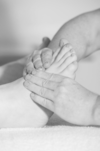Morton's disease or syndrome and osteopathy
What is Morton's disease?
Morton's syndrome was first described in 1876 by Thomas Morton.
This disease is due to the mechanical compression of a nerve of the foot generally located in the 3rd interdigital space. Indeed, this area is often a source of compression because of the heads of the 3rd and 4th metatarsals and the ligaments around them, which create an inextensible canal. The nerve is then trapped and compressed and sends signals that the patient perceives as pain, sometimes very intense.
The nerve will react by forming a fibrosis around it which will become bigger and bigger and thus reduce the area even more: this is called Morton's neuroma.
Causes of Morton's syndrome

The main causes identified in Morton's syndrome are all those that cause overload of the metatarsal heads:
- Wearing shoes that are too tight or pumps: the tightness of the shoes on the toes and metatarsals will cause a compression of the nerve that causes the neuroma.
- Mechanical foot disorder causing too much pressure on the heads of the metatarsals:
- Hollow feet
- Hallux valgus, etc.
Morton's disease clinic
Symptoms of Morton's syndrome
- Punchy pain under the forefoot
- sometimes tingling in the 3rd and 4th toes
- Sometimes insensitivity in these toes
- Pain increased by wearing tight shoes
- Increased pain when walking
Clinical examination of Morton's syndrome
Mulder's sign
This sign consists in pressing between the 3rd and 4th metatarsal in order to reproduce the pain linked to a possible Morton's neuroma that we will compress against the metatarsal with the fingers.
Lateral compression of the forefoot
With one hand, the practitioner squeezes the patient's forefoot gently and gradually. The Morton patient will quickly flinch and this test will reproduce the patient's known pain.
Additional tests for Morton's disease
Ultrasound
Ultrasound can show a Morton's neuroma. The radiologist will also be able to move the foot and see the neuroma mobilize against the heads of the metatarsals and reproduce the pain. This is the advantage of ultrasound in this case.
MRI

MRI is very expensive and not always accessible. However, it can give a precise image, especially in the early stages.
Treatment of Morton's syndrome
Orthopedic insoles

The orthopedic insoles or orthoses have for first role to treat the mechanical disorder of the foot which would cause an over-solicitation at the level of 3rd and/or 4th metatarsus at the origin of the creation of the neuroma. In cases of early Morton's disease, this treatment associated with manual therapies is sufficient.
The objective of the insoles is to relieve the painful area so that it is less stressed.
Infiltration
A series of corticosteroid infiltrations injected locally can relieve the patient. If this treatment fails, surgery can be considered.
The surgery
Surgery should never be considered as a first line treatment but only after the failure of the different possible treatments.
In case of an operation, two types of interventions are possible:
- The total resection of Morton's neuroma, that is to say that the nerve end that causes the pain is cut and removed. Even if this procedure allows a great relief, it tends to leave more post-operative sequelae starting with the formation of a scar neuroma and/or the insensitivity of the 3rd and 4th toes.
- The other type of surgery involves making room for the neuroma by opening the canal in which the neuroma is stuck.
Osteopathy and Morton's disease
In Morton's disease, the nerve between the 3rd and 4th toes is compressed. The osteopath will have to understand the cause of this compression and treat it in order to prevent the nerve from continuing to fibrose and also to limit the pressure on it.
But the osteopath's role will also be to treat the repercussions of Morton. Indeed, the patient has probably spent weeks or months dodging his gait and has therefore compensated with the rest of the body.
It is important that the osteopath works in a multidisciplinary manner with other professionals in order to provide maximum relief to the patient.
In the very advanced stages, osteopathy will only relieve the pain for a few days and a surgical treatment will have to be considered. But for the first stages, osteopathy has its full place in the management of Morton syndrome.

Marie Messager
Osteopath in Versailles
78000 - Yvelines
